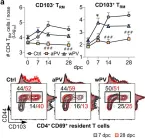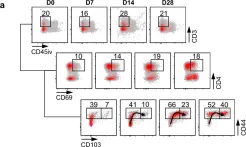The innate and adaptive immune systems, though often studied separately, interact deeply and respond to stimuli simultaneously, with leukocytes displaying a range of pro- to anti-inflammatory phenotypes. This protocol details a procedure for characterizing murine innate and adaptive immune phenotypes using a 40-color full-spectral flow cytometry panel. We describe steps for organ collection, sample preparation, immunofluorescent staining, and acquisition to reproducibly and cost-effectively study tissue-resident leukocytes, their subpopulations, and inflammatory status in various organs.
Copyright © 2024 The Authors. Published by Elsevier Inc. All rights reserved.
Product Citations: 11
In STAR Protocols on 20 December 2024 by Lemaitre, P., Mathieu, C., et al.
In JCI Insight on 22 September 2023 by Dubois, V., Chatagnon, J., et al.
Given the resurgence of pertussis, several countries have introduced maternal tetanus, diphtheria, and acellular pertussis (aP) vaccination during pregnancy to protect young infants against severe pertussis. Although protective against the disease, the effect of maternal aP vaccination on bacterial colonization of the offspring is unknown. Here, we used a mouse model to demonstrate that maternal aP immunization, either before or during pregnancy, protects pups from lung colonization by Bordetella pertussis. However, maternal aP vaccination resulted in significantly prolonged nasal carriage of B. pertussis by inhibiting the natural recruitment of IL-17-producing resident memory T cells and ensuing neutrophil influx in the nasal tissue, especially of those with proinflammatory and cytotoxic properties. Prolonged nasal carriage after aP vaccination is due to IL-4 signaling, as prolonged nasal carriage is abolished in IL-4Rα-/- mice. The effect of maternal aP vaccination can be transferred transplacentally to the offspring or via breastfeeding and is long-lasting, as it persists into adulthood. Maternal aP vaccination may, thus, augment the B. pertussis reservoir.
-
Mus musculus (House mouse)
-
Immunology and Microbiology
In Cell Reports on 30 May 2023 by Stellas, D., Karaliota, S., et al.
Locoregional monotherapy with heterodimeric interleukin (IL)-15 (hetIL-15) in a triple-negative breast cancer (TNBC) orthotopic mouse model resulted in tumor eradication in 40% of treated mice, reduction of metastasis, and induction of immunological memory against breast cancer cells. hetIL-15 re-shaped the tumor microenvironment by promoting the intratumoral accumulation of cytotoxic lymphocytes, conventional type 1 dendritic cells (cDC1s), and a dendritic cell (DC) population expressing both CD103 and CD11b markers. These CD103intCD11b+DCs share phenotypic and gene expression characteristics with both cDC1s and cDC2s, have transcriptomic profiles more similar to monocyte-derived DCs (moDCs), and correlate with tumor regression. Therefore, hetIL-15, a cytokine directly affecting lymphocytes and inducing cytotoxic cells, also has an indirect rapid and significant effect on the recruitment of myeloid cells, initiating a cascade for tumor elimination through innate and adoptive immune mechanisms. The intratumoral CD103intCD11b+DC population induced by hetIL-15 may be targeted for the development of additional cancer immunotherapy approaches.
Published by Elsevier Inc.
-
Mus musculus (House mouse)
-
Cancer Research
-
Immunology and Microbiology
In The Journal of Immunology on 1 May 2023 by Shamseldin, M. M., Kenney, A., et al.
Vaccines against SARS-CoV-2 that induce mucosal immunity capable of preventing infection and disease remain urgently needed. In this study, we demonstrate the efficacy of Bordetella colonization factor A (BcfA), a novel bacteria-derived protein adjuvant, in SARS-CoV-2 spike-based prime-pull immunizations. We show that i.m. priming of mice with an aluminum hydroxide- and BcfA-adjuvanted spike subunit vaccine, followed by a BcfA-adjuvanted mucosal booster, generated Th17-polarized CD4+ tissue-resident memory T cells and neutralizing Abs. Immunization with this heterologous vaccine prevented weight loss following challenge with mouse-adapted SARS-CoV-2 (MA10) and reduced viral replication in the respiratory tract. Histopathology showed a strong leukocyte and polymorphonuclear cell infiltrate without epithelial damage in mice immunized with BcfA-containing vaccines. Importantly, neutralizing Abs and tissue-resident memory T cells were maintained until 3 mo postbooster. Viral load in the nose of mice challenged with the MA10 virus at this time point was significantly reduced compared with naive challenged mice and mice immunized with an aluminum hydroxide-adjuvanted vaccine. We show that vaccines adjuvanted with alum and BcfA, delivered through a heterologous prime-pull regimen, provide sustained protection against SARS-CoV-2 infection.
Copyright © 2023 by The American Association of Immunologists, Inc.
-
FC/FACS
-
Mus musculus (House mouse)
-
COVID-19
-
Immunology and Microbiology
-
Pathology
In Frontiers in Immunology on 24 February 2023 by Swan, S. L., Mehta, N., et al.
Chimeric antigen receptor (CAR) T cell therapy in glioblastoma faces many challenges including insufficient CAR T cell abundance and antigen-negative tumor cells evading targeting. Unfortunately, preclinical studies evaluating CAR T cells in glioblastoma focus on tumor models that express a single antigen, use immunocompromised animals, and/or pre-treat with lymphodepleting agents. While lymphodepletion enhances CAR T cell efficacy, it diminishes the endogenous immune system that has the potential for tumor eradication. Here, we engineered CAR T cells to express IL7 and/or Flt3L in 50% EGFRvIII-positive and -negative orthotopic tumors pre-conditioned with non-lymphodepleting irradiation. IL7 and IL7 Flt3L CAR T cells increased intratumoral CAR T cell abundance seven days after treatment. IL7 co-expression with Flt3L modestly increased conventional dendritic cells as well as the CD103+XCR1+ population known to have migratory and antigen cross-presenting capabilities. Treatment with IL7 or IL7 Flt3L CAR T cells improved overall survival to 67% and 50%, respectively, compared to 9% survival with conventional or Flt3L CAR T cells. We concluded that CAR T cells modified to express IL7 enhanced CAR T cell abundance and improved overall survival in EGFRvIII heterogeneous tumors pre-conditioned with non-lymphodepleting irradiation. Potentially IL7 or IL7 Flt3L CAR T cells can provide new opportunities to combine CAR T cells with other immunotherapies for the treatment of glioblastoma.
Copyright © 2023 Swan, Mehta, Ilich, Shen, Wilkinson, Anderson, Segura, Sanchez-Perez, Sampson and Bellamkonda.
-
FC/FACS
-
Mus musculus (House mouse)
-
Immunology and Microbiology
In NPJ Vaccines on 8 January 2021 by Dubois, V., Chatagnon, J., et al.
Fig.3.A

-
FC/FACS
-
Mus musculus (House mouse)
Collected and cropped from NPJ Vaccines by CiteAb, provided under a CC-BY license
Image 1 of 2
In NPJ Vaccines on 8 January 2021 by Dubois, V., Chatagnon, J., et al.
Fig.2.A

-
FC/FACS
-
Mus musculus (House mouse)
Collected and cropped from NPJ Vaccines by CiteAb, provided under a CC-BY license
Image 1 of 2

